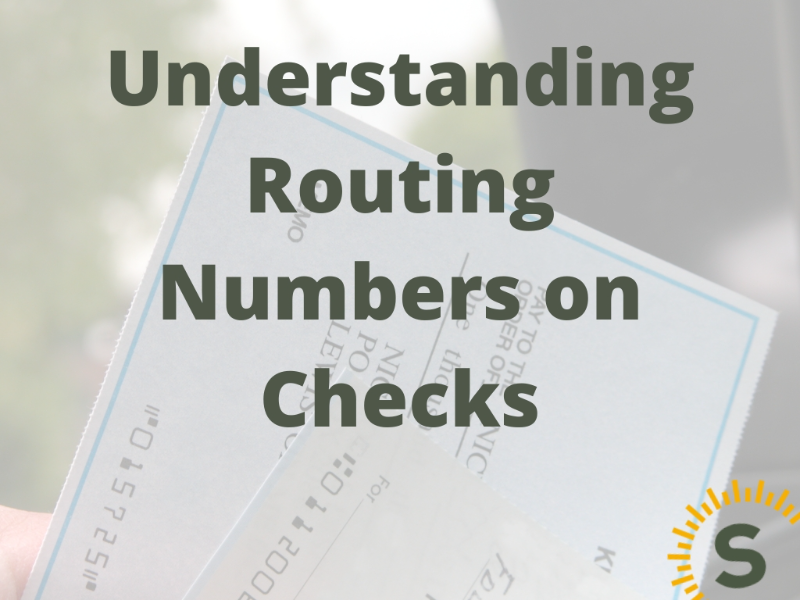
As you go about your financial transactions, you may have come across a set of numbers at the bottom of your checks. These numbers, known as routing numbers, play a crucial role in ensuring that your funds are transferred accurately between financial institutions. In this comprehensive guide, we will delve into the world of routing numbers on checks, exploring what they are, where to find them, and how they are used. So let's begin our journey into the realm of routing numbers on checks!
Routing numbers are unique, nine-digit numbers that serve as identifying codes for banks and credit unions. They facilitate secure and efficient electronic transactions, such as direct deposits, funds transfers, bill payments, and digital checks. Think of a routing number as an address that directs your money to the right financial institution.
To find the routing number on a check, simply flip it over and look at the bottom left corner. There, you will see a series of numbers printed in magnetic ink. The routing number is typically the first set of nine digits in this line. It is important to note that the characters surrounding the routing number are not part of the actual routing number itself.
Before we dive deeper into routing numbers, let's take a moment to understand the different components of a check. Familiarizing yourself with these elements will help you navigate the world of routing numbers with ease. Here are the key components you'll find on a typical check:
Routing numbers play a crucial role in ensuring the smooth and accurate transfer of funds between financial institutions. Here are some key reasons why routing numbers are important:
While checks are the most common place to find your routing number, there are alternative methods to locate this important piece of information. Here are some ways you can find your routing number without a physical check:
Routing numbers can vary based on the region where you opened your bank account. While the first few digits of the routing number generally correspond to the location of the bank, it's essential to confirm the correct routing number for your specific account. Here are some examples of regional routing numbers:
|
State |
Routing Number |
|---|---|
| Alabama | 051000017 |
| California | 121000358 |
| Florida | 063100277 |
| New York | 021000322 |
| Texas | 111000025 |
It's important to note that the list above is not exhaustive, and routing numbers can change due to bank mergers, acquisitions, or other operational changes. Always verify the routing number with your bank to ensure accuracy.
A routing number and an account number are two distinct pieces of information used in financial transactions, particularly for electronic fund transfers like direct deposits and payments. Here's the difference between them:
In summary, the routing number is like the "address" of your bank, ensuring money is sent to the right financial institution, while the account number is like the "apartment number" within that bank, specifying which individual account the funds should be directed to or withdrawn from. Both are essential for accurate and secure electronic transactions.
Routing Number: Look at the bottom left corner of your personal check. The nine-digit number there is your routing number. It's typically the first set of numbers, and it's printed in magnetic ink. Be sure not to confuse it with the check number, which is usually at the top right.
Account Number: Your account number is typically found to the right of the routing number on the bottom of your check. This is your specific account number with the bank.
Routing Number: If you use online banking, you can usually find your routing number after logging into your account. Look for account details, statements, or account settings. The routing number may be displayed there.
Account Number: You can also find your account number in the same online banking portal, often under account details or account summary.
Routing Number: Your bank statements, whether received electronically or by mail, will typically contain your routing number. Look for the section that displays your account information.
Account Number: Your account number should also be on your bank statement, usually near your name and address.
Routing numbers on checks are vital for ensuring the accurate and secure transfer of funds between financial institutions. By understanding the purpose of routing numbers, locating them on checks, and knowing alternative methods to find them, you can navigate the world of electronic transactions with confidence. Whether you're setting up direct deposit, making bill payments, or transferring funds, routing numbers play a crucial role in facilitating seamless financial transactions. Remember to consult with your bank or credit union if you have any further questions or concerns about routing numbers and their usage.

Stuart is an expert in Property, Money, Banking & Finance, having worked in retail and investment banking for 10+ years before founding Sunny Avenue. Stuart has spent his career studying finance. He holds qualifications in financial studies, mortgage advice & practice, banking operations, dealing & financial markets, derivatives, securities & investments.





Our website offers information about financial products such as investing, savings, equity release, mortgages, and insurance. None of the information on Sunny Avenue constitutes personal advice. Sunny Avenue does not offer any of these services directly and we only act as a directory service to connect you to the experts. If you require further information to proceed you will need to request advice, for example from the financial advisers listed. If you decide to invest, read the important investment notes provided first, decide how to proceed on your own basis, and remember that investments can go up and down in value, so you could get back less than you put in.
Think carefully before securing debts against your home. A mortgage is a loan secured on your home, which you could lose if you do not keep up your mortgage payments. Check that any mortgage will meet your needs if you want to move or sell your home or you want your family to inherit it. If you are in any doubt, seek independent advice.